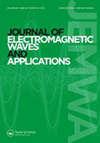可编程分束超表面设计
IF 1.1
4区 工程技术
Q4 ENGINEERING, ELECTRICAL & ELECTRONIC
Journal of Electromagnetic Waves and Applications
Pub Date : 2023-09-15
DOI:10.1080/09205071.2023.2258866
引用次数: 0
摘要
摘要超表面已成为电磁调制器件的重要平台之一。本文提出了一种加载PIN二极管的可编程超表面,实现任意多波束的动态切换。利用遗传算法对多波束编码序列进行优化,实现了不同散射方向的双波束到九波束编码。作为概念验证,设计和制造了一个工作在8 GHz左右的可编程超表面原型,用于远场测量测试。经理论分析和数值模拟验证,该分束器的功率效率可达70%以上。在测量系统中,通过直流控制PIN二极管的“开”和“关”,得到了多束分裂现象,与仿真结果一致。该分束器可实现实时多波束切换,并能智能地提供多方向角编码序列,为下一代天线提供潜在优势。关键词:可编程元表面智能优化分束器动态控制披露声明作者未报告潜在利益冲突。数据的可得性本文中提出的结果所依据的数据应合理要求可从作者处获得。本研究由国家自然科学基金资助[批准号:12273012]。作者简介李黎,南京林业大学信息技术学院,南京,中国。滕燕,南京林业大学信息技术学院,南京,中国肖玉华,南京林业大学信息技术学院,南京,中国李春,南京林业大学信息技术学院,南京,中国卞伯瑞,南京林业大学信息技术学院,南京,中国岳娟,南京林业大学信息技术学院,南京,中国蒋玲* 2001年毕业于华中师范大学,获理学学士学位;2007年毕业于中国科学院南京紫金山天文台,获博士学位。现任南京林业大学信息技术学院教授。她的研究兴趣包括电磁超材料、人工智能和机器学习算法以及太赫兹光谱和成像应用。电子邮件:jiangling@njfu.edu.cn本文章由计算机程序翻译,如有差异,请以英文原文为准。
Design of programmable beam splitting metasurface
AbstractMetasurface has been applied as one critical platform for electromagnetic modulation devices. Here, a programmable metasurface loaded with positive-intrinsic negative (PIN) diodes is proposed to realize dynamic switching of arbitrary multi-beam. Furthermore, the multi-beam coding sequence is optimized by a genetic algorithm (GA) to achieve dual- to nine-beam with different scattering directions. As a proof of concept, a programmable metasurface prototype that operates around 8 GHz is designed and fabricated to be tested in far-field measurements. The beam splitter has been verified by theoretical analysis and numerical simulation to have a power efficiency of over 70%. In the measurement system, multi-beam splitting phenomena are obtained using DC control of the PIN diodes “on” and “off”, which is consistent with the simulation results. The proposed beam splitter can be designed with real-time multi-beam switching and intelligently provides coding sequences with multiple directive angles, thus providing potential benefits for next-generation antennas.KEYWORDS: Programmable metasurfaceintelligent optimizationbeam splitterdynamic control Disclosure statementNo potential conflict of interest was reported by the author(s).Data availabilityData underlying the results presented in this paper are available from the authors upon reasonable request.Additional informationFundingThis work was supported by National Natural Science Foundation of China [grant number: 12273012].Notes on contributorsShaochen LiLi Shaochen, College of Information Technology, Nanjing Forestry University, Nanjing, China.Teng YanTeng Yan, College of Information Technology, Nanjing Forestry University, Nanjing, China.Xiao YuhuaXiao Yuhua, College of Information Technology, Nanjing Forestry University, Nanjing, China.Li ChunLi Chun, College of Information Technology, Nanjing Forestry University, Nanjing, China.Bian BoruiBian Borui, College of Information Technology, Nanjing Forestry University, Nanjing, China.Juan YueJuan Yue, College of Information Technology, Nanjing Forestry University, Nanjing, China.Jiang LingJiang Ling* received the B.E. degree from Central China Normal University, Wuhan, China, in 2001, and the Ph.D. degree from Purple Mountain Observatory, Chinese Academy of Sciences, Nanjing, China, in 2007. She is currently a Professor at the College of Information Technology, Nanjing Forestry University, Nanjing, China. Her research interests include Electromagnetic Metamaterials, artificial intelligence and machine learning algorithms and terahertz spectroscopy and imaging applications. e-mail: jiangling@njfu.edu.cn
求助全文
通过发布文献求助,成功后即可免费获取论文全文。
去求助
来源期刊
CiteScore
3.60
自引率
7.70%
发文量
116
审稿时长
3.3 months
期刊介绍:
Journal of Electromagnetic Waves and Applications covers all aspects of electromagnetic wave theory and its applications. It publishes original papers and review articles on new theories, methodologies, and computational techniques, as well as interpretations of both theoretical and experimental results.
The scope of this Journal remains broad and includes the following topics:
wave propagation theory
propagation in random media
waves in composites and amorphous materials
optical and millimeter wave techniques
fiber/waveguide optics
optical sensing
sub-micron structures
nano-optics and sub-wavelength effects
photonics and plasmonics
atmospherics and ionospheric effects on wave propagation
geophysical subsurface probing
remote sensing
inverse scattering
antenna theory and applications
fields and network theory
transients
radar measurements and applications
active experiments using space vehicles
electromagnetic compatibility and interferometry
medical applications and biological effects
ferrite devices
high power devices and systems
numerical methods
The aim of this Journal is to report recent advancements and modern developments in the electromagnetic science and new exciting applications covering the aforementioned fields.

 求助内容:
求助内容: 应助结果提醒方式:
应助结果提醒方式:


